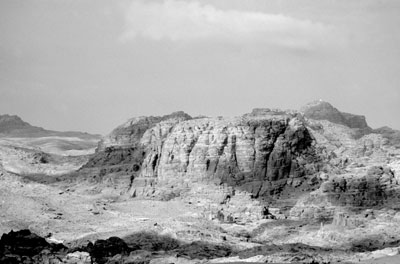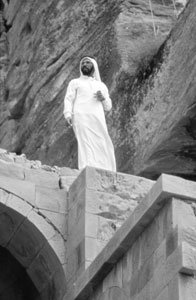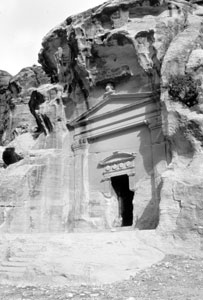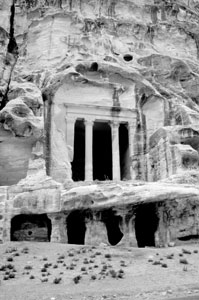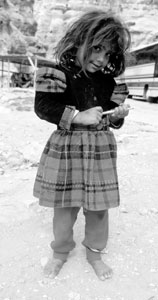Unknown Little Petra
by Ed Kinney
Moreen and I have been fortunate to have twice visited Petra, Jordan. To us, it is one of the crown jewels of the Middle East, along with Syria’s Palmyra and Lebanon’s Baalbek. (Egypt’s treasures are in Africa.)
The first time we visited the rose-red city of Petra was in 1982. Then, the Middle East was inflamed with Israel and Syria fighting in Lebanon and Syrian ruler Hafez al-Assad subduing the Muslim Brotherhood in Hama, Syria. In our naivete, we were traveling alone in these countries, which were vacant of tourists and thus offered us uncluttered access to sites plus wonderful contacts with locals anxious to meet a North American couple. It was a “thrilling” trip, with side adventures we’ll never forget.
During that trip we rode through Petra’s famous siq (narrow entranceway) on two old horses. Mine was so swayback, my feet dragged in the red sand. Moreen claimed I looked like Icabod Crane. On our second visit, several years ago, we walked in among hundreds of tourists.
Did we enjoy Petra as much the second time. Possibly not. We were, however, better prepared, having read several books about Petra which gave us additional insight plus an update on recent excavations, etc. Disappointedly, Little Petra was not mentioned in any of these books.
Al Beidha
Though located only about 10 minutes away from Petra via a paved road, al Beidha (Little Petra) is seldom visited by tourists. Similar in many ways to its big brother or sister, it certainly is not as spectacular.
Some believe Little Petra was once an important suburb, located where caravan routes that linked the Arabian Peninsula, Gaza, Egypt and the Mediterranean coast converged.
At Little Petra’s entrance, there is a classical temple guarding a narrow, 350-meter entrance ravine called Siq al-Barid. This siq, similar to Petra’s, leads to temples, tombs, houses, water channels and cisterns carved out of the same red rock as seen in Petra. There are also the partial remains of a painted fresco dating from the first century, A.D., on one of these houses.
On the morning we visited Little Petra there were no other tourists. The only person we saw was a young, shy Bedouin girl standing by her family’s tent. None of her family ever appeared, possibly because we already had a guide.
The Internet reports that bedouins now have a campsite nearby which includes a small bedouin museum.
For those traveling alone and seeking a guide, I’d recommend having a hotel in Petra arrange for a private English-speaking guide licensed by the Jordanian Ministry of Tourism. A licensed guide can both escort and arrange travel to Little Petra and possibly lead the adventuresome over a back road trail that goes from Little Petra to Petra. This hike appears rugged.
So why visit Little Petra after having seen magnificent Petra? I could simply say, “Will you ever have this opportunity again?,” but I’d prefer to quote poet Robert Frost:
“Two roads diverged in a wood, and I took the one less traveled by, and that has made all the difference.”
Minutiae
• There are several excellent webpages with comments and photos by travelers who have recently visited Little Petra. Using Yahoo, Google, etc., type “Little Petra.”
For general data re Jordan, go to www.jordanhere.com or www.seejordan.org. For other tourism information, write to the Jordan Tourism Board, 6867 Elm St., Ste. 102, McLean, VA 22101, or phone 703/243-7404.
• In May 2005, the American Center of Oriental Research (ACOR), funded by the U.S. Agency for International Development, completed another season of excavation in al Beidha. This season, they uncovered a Nabataean banquet hall and 22 stone heads of ancient gods.
• Walking tours from Little Petra to Petra via Baidha, a Neolithic site, cost $40. This price does not include an entrance fee to Petra. There is no charge to visit Little Petra.
• There are now many fine hotels located at Petra. We stayed in the Mövenpick Hotel, only 10 minutes from the entrance. The room price currently quoted on the Internet is 158 Jordanian pounds (near $223).
• There is no travel advisory for Jordan at this time, but readers should always use caution when visiting many of the countries discussed in this column.
Coming up: Though not exactly in the Middle East, let’s next visit northern Pakistan, cruelly destroyed in October 2005’s massive earthquake.

